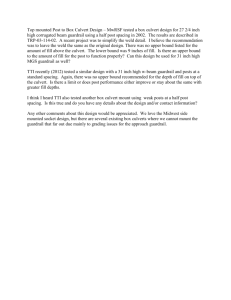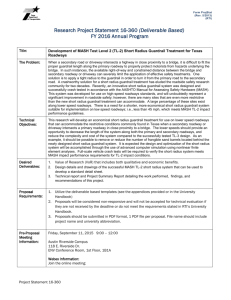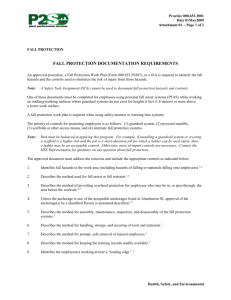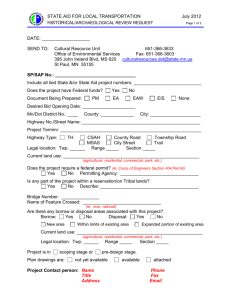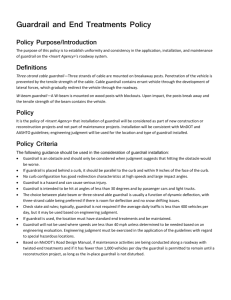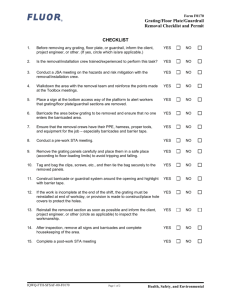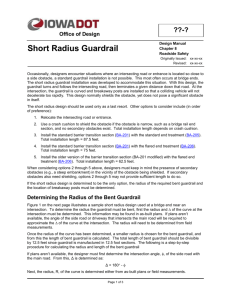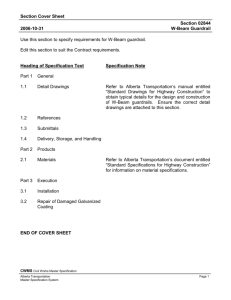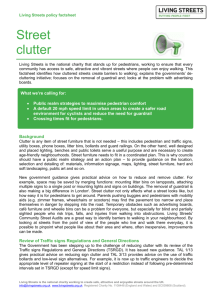Guardrail Block Specifications
advertisement
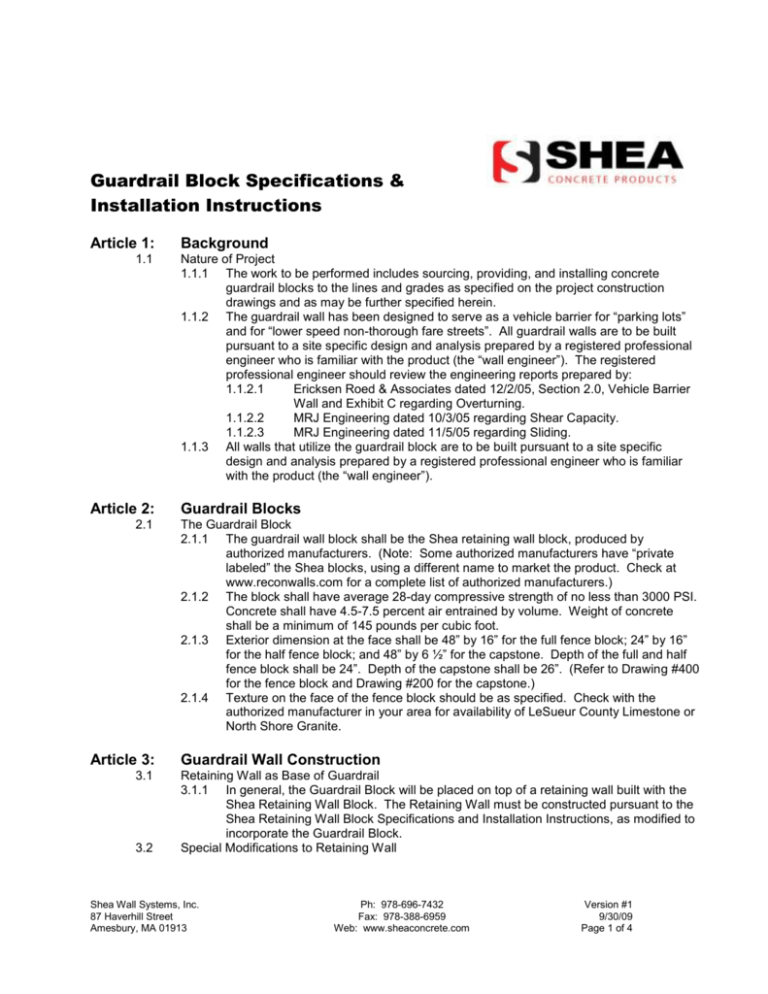
Guardrail Block Specifications & Installation Instructions Article 1: 1.1 Article 2: 2.1 Article 3: 3.1 3.2 Background Nature of Project 1.1.1 The work to be performed includes sourcing, providing, and installing concrete guardrail blocks to the lines and grades as specified on the project construction drawings and as may be further specified herein. 1.1.2 The guardrail wall has been designed to serve as a vehicle barrier for “parking lots” and for “lower speed non-thorough fare streets”. All guardrail walls are to be built pursuant to a site specific design and analysis prepared by a registered professional engineer who is familiar with the product (the “wall engineer”). The registered professional engineer should review the engineering reports prepared by: 1.1.2.1 Ericksen Roed & Associates dated 12/2/05, Section 2.0, Vehicle Barrier Wall and Exhibit C regarding Overturning. 1.1.2.2 MRJ Engineering dated 10/3/05 regarding Shear Capacity. 1.1.2.3 MRJ Engineering dated 11/5/05 regarding Sliding. 1.1.3 All walls that utilize the guardrail block are to be built pursuant to a site specific design and analysis prepared by a registered professional engineer who is familiar with the product (the “wall engineer”). Guardrail Blocks The Guardrail Block 2.1.1 The guardrail wall block shall be the Shea retaining wall block, produced by authorized manufacturers. (Note: Some authorized manufacturers have “private labeled” the Shea blocks, using a different name to market the product. Check at www.reconwalls.com for a complete list of authorized manufacturers.) 2.1.2 The block shall have average 28-day compressive strength of no less than 3000 PSI. Concrete shall have 4.5-7.5 percent air entrained by volume. Weight of concrete shall be a minimum of 145 pounds per cubic foot. 2.1.3 Exterior dimension at the face shall be 48” by 16” for the full fence block; 24” by 16” for the half fence block; and 48” by 6 ½” for the capstone. Depth of the full and half fence block shall be 24”. Depth of the capstone shall be 26”. (Refer to Drawing #400 for the fence block and Drawing #200 for the capstone.) 2.1.4 Texture on the face of the fence block should be as specified. Check with the authorized manufacturer in your area for availability of LeSueur County Limestone or North Shore Granite. Guardrail Wall Construction Retaining Wall as Base of Guardrail 3.1.1 In general, the Guardrail Block will be placed on top of a retaining wall built with the Shea Retaining Wall Block. The Retaining Wall must be constructed pursuant to the Shea Retaining Wall Block Specifications and Installation Instructions, as modified to incorporate the Guardrail Block. Special Modifications to Retaining Wall Shea Wall Systems, Inc. 87 Haverhill Street Amesbury, MA 01913 Ph: 978-696-7432 Fax: 978-388-6959 Web: www.sheaconcrete.com Version #1 9/30/09 Page 1 of 4 3.2.1 3.3 3.4 As specified in the site specific design and analysis prepared by the wall engineer, a minimum of the top two courses of the retaining wall will be the 45” deep block modified to have two 4” diameter ribbed holes running through the block at 24” on center. These holes must align with the holes in the Guardrail Block. Placement of Guardrail Block 3.3.1 Guardrail Block (maximum of two courses) is to be placed on the top course of the retaining wall portion of the wall. Take care to make sure that the holes align through both courses of the Guardrail Block and the top two courses on the retaining wall. 3.3.2 Reinforcement of Guardrail and Retaining Wall Block shall be as per the site specific wall design. In general, rebar (type as specified) shall be placed at 24” on center intervals through the two courses of Guardrail Block and the top two courses of Retaining Wall Block, with the holes filled with concrete. 3.3.3 The top of the Guardrail Wall should be finished using the Capstone. The Capstone must be glued to the Guardrail Block using a concrete adhesive. Turning Radius 3.4.1 Given the design of the Guardrail Block with an “end to end tongue and groove”, it is possible to do curved walls using the standard Guardrail Block. When building curved guardrail walls, be aware that on the outside / concave curve side of the wall there will be a “gap” between the textured portion of the guardrail blocks. However, the tongue which protrudes from the end of the Guardrail Block will fill that “gap” so that the wall remains a solid wall with no visible spaces or gaps into the wall itself. 3.4.2 Minimum Turning Radius, Inside / Convex Curve 3.4.2.1 It is important that the 4” diameter holes in the Guardrail and the Retaining Wall Block remain aligned as the wall curves so that these holes can be filled with rebar and concrete. 3.4.2.2 The very minimum radius for an inside curve is 35 feet with a .8 inch spacing left between the Guardrail Blocks when placed end to end (see Drawing #402). It is recommended that the radius be no less than 50 feet to avoid frustration in the field. 3.4.3 Minimum Turning Radius, Outside / Concave Curve 3.4.3.1 It is important that the 4” diameter holes in the Guardrail and the Retaining Wall Block remain aligned as the wall curves so that these holes can be filled with rebar and concrete. 3.4.3.2 The very minimum radius for an outside curve is 40 feet with a 2” cut / removal of the inside wing of the Guardrail Block in the field (see Drawing #s 400 and 403). Once again, it is recommended that the radius be no less than 50 feet to avoid frustration in the field. 3.4.4 A curved wall can reduce the “engineered strength” of the Guardrail Wall. This is particularly the case with an Inside / Convex Curve. It is important that the registered professional engineer that designed the wall be aware of the curves in the wall and consider the impact of the curves in the design of the wall. 3.4.5 Capstone Placement 3.4.5.1 With a curved wall, the Capstone Block will need to be cut in the field before it is installed and glued. Article 4: Staining and Sealing 4.1 Staining 4.1.1 4.1.2 Shea Wall Systems, Inc. 87 Haverhill Street Amesbury, MA 01913 Before staining, the wall should be power washed and allowed to dry. This removes any dirt and / or form oil from the face of the block. This is very important. Recommended stains include Sherwin Williams H & C Shield Plus Concrete Stain or TK Products Stain #5272. Both are latex / water based and can be applied with Ph: 978-696-7432 Fax: 978-388-6959 Web: www.sheaconcrete.com Version #1 9/30/09 Page 2 of 4 4.1.3 4.1.4 4.2 Sealing 4.2.1 4.2.2 either an electric airless sprayer or a compressed air sprayer. Sherwin Williams is available at retail outlets across the country. For a distributor of the TK Products near you, contact TK Products at 11400 West 47th Street, Minnetonka, MN 55343, 1800-441-2129. It is suggested that you have your customer provide to you a sample of the color they want to replicate. That color can then be taken to the stain distributor and used to mix the base coat and the highlights. Some staining contractors may have samples that they can provide to you to choose from. The concrete should be at least 28 day cured before staining. The wall can be stained a one coat one color stain, or it can be stained with a base color and then highlighted with several different shades to more closely approximate a weathered natural stone look. Generally, the “highlights” are applied to several blocks in a random fashion, and then before the highlights dry, they are wiped out with a wet sponge. This helps to blend the highlights into the block, making them look more natural. For the Northshore Granite texture, you may want to apply flecks of black, silver or white to create a natural granite look. The stain should not be applied if it is going to be below 45 degrees prior to the stain having a chance to dry. Consult the manufacturer’s instructions for proper application of the stains. Some customers ask that their wall be sealed. This may be particularly relevant if the wall is in a road splash zone where winter road salts might get on the face of the wall. If you are using the TK Products stain, then TK Products also sells a number of sealers that are compatible with their stains, including TK-290-12. This is a solventbased 12% Siloxane sealer. The manufacturer indicates that it must be 32 degrees or above before this should be applied. In addition, the blocks must be completely and thoroughly dry before sealing. This is more than just dry to the surface touch. The water and the mineral based sealer do not mix. Thus, after the power wash, you will need dry warm weather and the passage of time before the sealer can be applied. Yes, the sealer is applied before the stain is applied. Article 5: Warranty 5.1 5.2 5.3 Each Block will have a 28 day compressive strength of at least 3000 PSI for 15 years after proper installation. If a Block does not meet this warranty standard, please notify the manufacturer in writing. If after it has been determined that the Block has not met the specifications, the manufacturer will have shipped to you, replacement Blocks which shall be the manufacturer’s sole remedy for breach of this warranty. However, neither the manufacturer nor Shea Wall Systems, Inc. shall have any obligation to install such replacement Blocks. This warranty shall not apply to any Block which is damaged, defective or fails to meet the warranty standard due to improper installation of the Block, chemical contact, structural design of the wall, or excessive and unforeseen site conditions beyond the manufacturer’s or Shea Wall Systems, Inc.’s control. The above warranty is the exclusive limited product warranty. ALL OTHER WARRANTIES, EXPRESS OR IMPLIED, INCLUDING WARRANTIES OF MERCHANTABILITY OR FITNESS FOR A PARTICULAR PURPOSE, ARE DISCLAIMED Shea Wall Systems, Inc. 87 Haverhill Street Amesbury, MA 01913 Ph: 978-696-7432 Fax: 978-388-6959 Web: www.sheaconcrete.com Version #1 9/30/09 Page 3 of 4 Index of Important Construction Detail Drawings: #400A #400B #401 #402 #403 Guardrail Block Dimensions (Top Down View) Guardrail Block Dimensions (End View) Retaining Wall, Guardrail, and Capstone Cross Section Turning Radius, Inside / Convex Curve Turning Radius, Outside / Concave Curve #300 Fence Block Types #200 Capstone Block #100 – 116 Companion Retaining Wall Block Drawings Index of Important Engineering Reports: Ericksen Roed & Associates Structural Engineers Report dated 12/2/05, Section 2.0, Vehicle Barrier Wall and Exhibits B and C. MRJ Engineering dated 10/3/05 regarding Shear Capacity. MRJ Engineering dated 11/5/05 regarding Sliding. Shea Wall Systems, Inc. 87 Haverhill Street Amesbury, MA 01913 Ph: 978-696-7432 Fax: 978-388-6959 Web: www.sheaconcrete.com Version #1 9/30/09 Page 4 of 4
